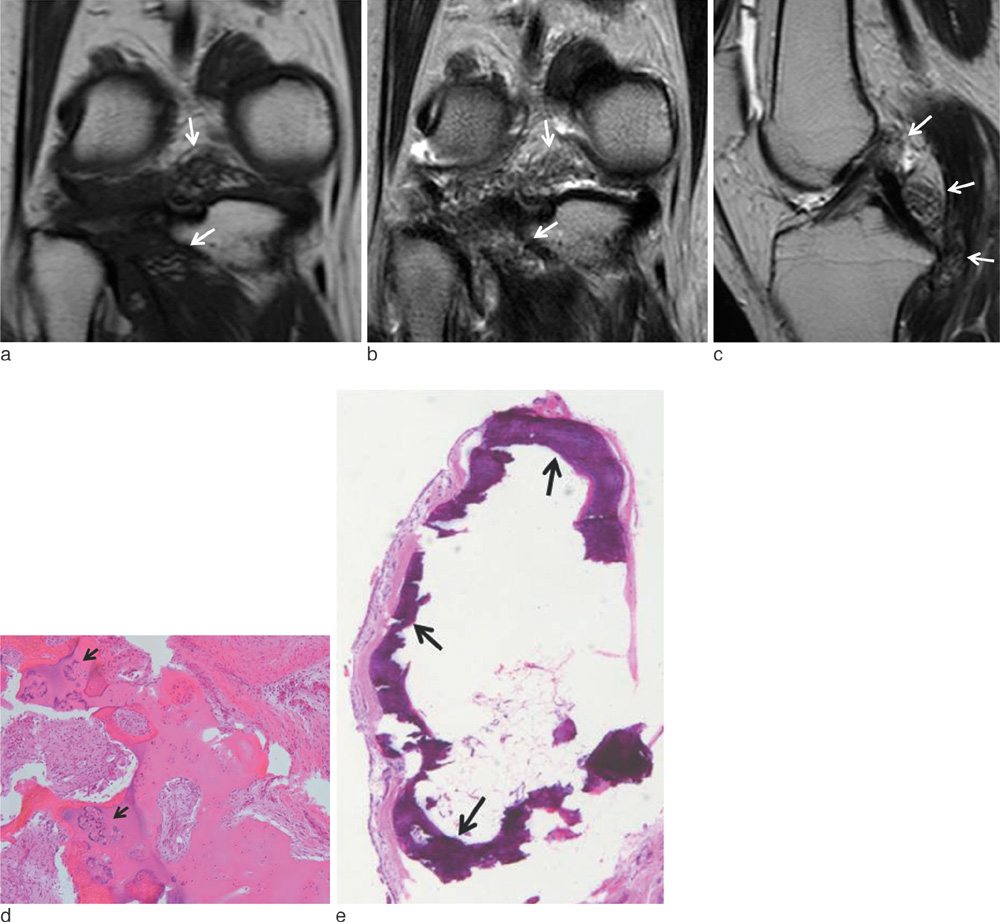J Korean Soc Magn Reson Med.
2011 Apr;15(1):1-10. 10.13104/jksmrm.2011.15.1.1.
Synovial Lesions with Low Signal Intensities on T2-Weighted MR Image
- Affiliations
-
- 1Department of Radiology, Inje University Pusan Paik Hospital, Busan, Korea. tjswnlee@paran.com
- 2Department of Radiology, Yeungnam University Medical Center, Daegu, Korea.
- 3Department of Radiology, Dongguk University Gyeongju Hospital, Gyeongju, Korea.
- 4Department of Radiology, Keimyung University Dongsan Medical Center, Daegu, Korea.
- 5Department of Radiology, Daegu Catholic University Medical Center, Daegu, Korea.
- 6Department of Radiology, Pusan National University Hospital, Busan, Korea.
- 7Department of Radiology, Hallym University Hangang Sacred Heart Hospital, Seoul, Korea.
- 8Department of Pathology, Inje University Pusan Paik Hospital, Busan, Korea.
- KMID: 2041222
- DOI: http://doi.org/10.13104/jksmrm.2011.15.1.1
Abstract
- Pigmented villonodular synovitis, synovial chondromatosis, long-standing rheumatoid arthritis, hemophilic arthropathy, chronic tophaceous gout, amyloid arthropathy, tuberculous arthritis, and hemangioma are the synovial diseases showing low signal intensity on T2-weighted image. Synovial deposition of hemosiderin, urate, and amyloid and fibrosis or caseous necrosis of hypertrophied synovium are known as the pathologic causes of T2 signal intensity. Because of the low incidence of the synovial lesions showing T2 low signal intensity, recognition of these diseases would be helpful for the exact diagnosis.
Keyword
MeSH Terms
Figure
Reference
-
1. Narváez JA, Narváez J, Ortega R, De Lama E, Roca Y, Vidal N. Hypointense synovial lesions on T2-weighted images: differential diagnosis with pathologic correlation. AJR Am J Roentgenol. 2003. 181:761–769.2. Chen CK, Yeh LR, Pan HB, et al. Intra-articular gouty tophi of the knee: CT and MR imaging in 12 patients. Skeletal Radiol. 1999. 28:75–80.3. Huang G-S, Lee C-H, Chan W, Chen C-Y, Yu J, Resnick D. Localized nodular synovitis of the knee: MR imaging appearance and clinical correlates in 21 patients. AJR Am J Roentgenol. 2003. 181:539–543.4. Murphey M, Vidal J, Fanburg-Smith J, Gajewski D. Imaging of synovial chondromatosis with radiologic-pathologic correlation. Radiographics. 2007. 27:1465–1488.5. Stiskal MA, Neuhold A, Szolar DH, et al. Rheumatoid arthritis of the craniocervical region by MR imaging: detection and characterization. AJR Am J Roentgenol. 1995. 165:585–592.6. Suh JS, Lee JD, Cho JH, Kim MJ, Han DY, Cho NH. MR imaging of tuberculous arthritis: clinical and experimental studies. J Magn Reson Imaging. 1996. 6:185–189.7. Frick M, Wenger D, Adkins M. MR imaging of synovial disorders of the knee: an update. Radiol Clin North Am. 2007. 45:1017–1031.8. Luck J, Silva M, Rodriguez-Merchan EC, Ghalambor N, Zahiri C, Finn R. Hemophilic arthropathy. J Am Acad Orthop Surg. 2004. 12:234–245.9. Yu JS, Chung C, Recht M, Dailiana T, Jurdi R. MR imaging of tophaceous gout. AJR Am J Roentgenol. 1997. 168:523–527.10. Chung C, Boucher R, Resnick D. MR imaging of synovial disorders of the knee. Semin Musculoskelet Radiol. 2009. 13:303–325.11. Otake S, Tsuruta Y, Yamana D, Mizutani H, Ohba S. Amyloid arthropathy of the hip joint: MR demonstration of presumed amyloid lesions in 152 patients with long-term hemodialysis. Eur Radiol. 1998. 8:1352–1356.12. Hong SH, Kim SM, Ahn JM, Chung HW, Shin MJ, Kang HS. Tuberculous versus pyogenic arthritis: MR imaging evaluation. Radiology. 2001. 218:848–853.13. Sanghvi D, Iyer V, Deshmukh T, Hoskote S. MRI features of tuberculosis of the knee. Skeletal Radiol. 2009. 38:267–273.14. Helpert C, Davies AM, Evans N, Grimer RJ. Differential diagnosis of tumours and tumour-like lesions of the infrapatellar (Hoffa's) fat pad: pictorial review with an emphasis on MR imaging. Eur Radiol. 2004. 14:2337–2346.
- Full Text Links
- Actions
-
Cited
- CITED
-
- Close
- Share
- Similar articles
-
- MR Findings of Extraabdominal Desmold Tumors: Correlation with H istopathologic Findings
- Ring Lesions in MR Imaging of the Liver
- MR imaging of the osteomyelitis of the extremities
- MR Imaging with FLAIR Pulse Sequence in Various Cerebral Lesions: Comparison with T2-Weighted Imaging
- Analysis of High Signal Intensities of Nontumorous Conditions of Corpus Callosum on Magnetic Resonance T2-Weighted Images










